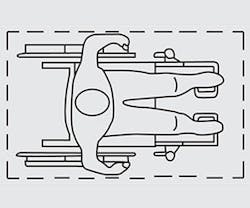Commercial real estate professionals who are unfamiliar with the Americans with Disabilities Act (ADA) are hard to find, given the large impact that the federal legislation has had on their industry since it was enacted in 1990.
Less familiar is the impact on the local level. Accessibility “standards” developed outside of the federal regulatory process have had an effect on local and state building regulations.
The A117.1 Standard for Accessible and Usable Buildings and Facilities provides guidance to ensure that spaces are accessible for people with disabilities. Developed by the International Code Council (ICC), the A117.1 Standard is certified by the American National Standards Institute (ANSI), the sanctioning body for thousands of U.S. standards.
The A117.1 Standard has a direct connection to accessibility regulations in your community. Provisions in the standard are incorporated into the national model building codes adopted by most local and state governments. Moreover, A117.1 provisions are coordinated with the federal ADA Accessibility Guideline (ADAAG).
While compliance with the A117.1 Standard or with building codes containing A117.1 provisions does not ensure compliance with the ADAAG or ADA, revisions to the ADAAG regularly include requirements taken directly from A117.1. In fact, it’s fair to say that the ongoing development of the A117.1 Standard sets the stage for what is ultimately included in federal regulations guiding ADA compliance.
Some Proposed Changes to A117.1-2009
Among the proposals to the accessibility standard that would have the greatest impact on commercial buildings are the following:
- Increasing the clear floor space for wheeled mobility devices. This increase would result in greater widths for restrooms, toilet stalls, work areas, and many other spaces. It would impact office, industrial, retail, and other types of commercial buildings.
- Increasing turning spaces by 7 inches. This change would require much greater space for bathrooms as well as other spaces, such as kitchens and break rooms.
- Retaining 36-inch interior corridor widths but adding multiple options for widths up to 40 inches.
- Changing unobstructed forward-reach dimensions, a requirement that would impact the location of electrical outlets, switches, and controls.
- Significantly increasing the width of accessible toilet compartments.
- Increasing the width of exterior accessible routes. This change could limit design options on some building sites and increase the cost of some sidewalks, such as those leading from a parking lot to a building entrance.
Like all ANSI-certified standards, A117.1 is updated regularly. The current version was released in 2009, and the consensus development committee recently began considering possible modifications for a planned 2015 edition. More than 300 proposed changes have been submitted.
The process includes consideration of each proposal in open public meetings; an initial committee vote to approve, modify or disapprove changes; a public comment period open to anyone wishing to file a comment on committee actions; and a final committee disposition of each proposed change followed by an appeals process.
Concerns about Wheeled Mobility Devices
The commercial real estate industry has voiced concerns about some of the proposed changes to the standard. Most involve the dimensions required to accommodate persons using wheeled mobility devices, especially the latest motorized wheelchairs, scooters, and similar devices. The initial ADAAG edition and the A117.1 editions published to date have focused largely on dimensions to accommodate manually operated wheelchairs rather than those of motorized devices.
The latest proposals were triggered by the publication of a major study of wheeled mobility devices by the Center for Inclusive Design and Environmental Access (IDeA Center) at the University at Buffalo, the State University of New York. Accommodating motorized mobility devices will have a major impact on new buildings and renovations. Among the considerations are the location of light switches, electrical outlets, wall-mounted dispensers, and plumbing fixtures. Other issues include elevator controls and reach ranges over counters.
While the A117.1 process continues, many of these proposed changes will also be submitted for updates to the next editions of national model codes, such as ICC’s International Building Code and the Life Safety Code published by the National Fire Protection Association (NFPA).
Savvy commercial real estate professionals will want to stay familiar with the ongoing discussion.
Ron Burton is the codes consultant for the Building Owners and Managers Association International (BOMA). He can be reached at [email protected].
